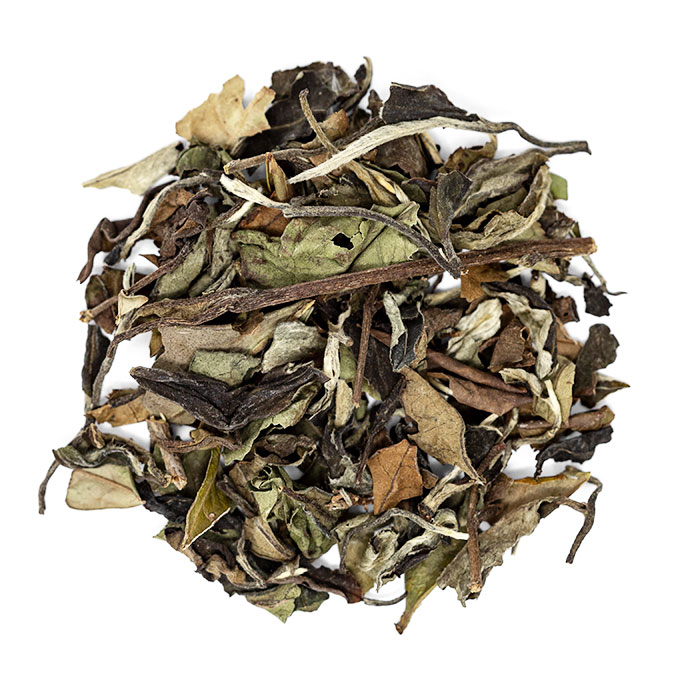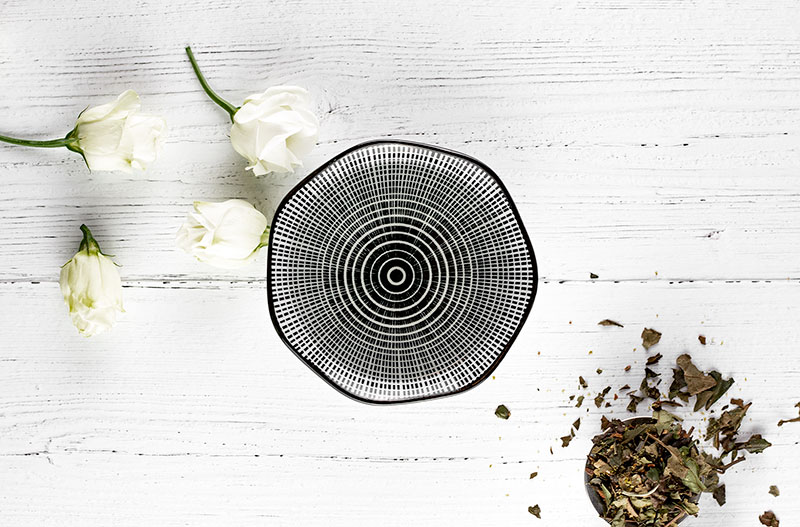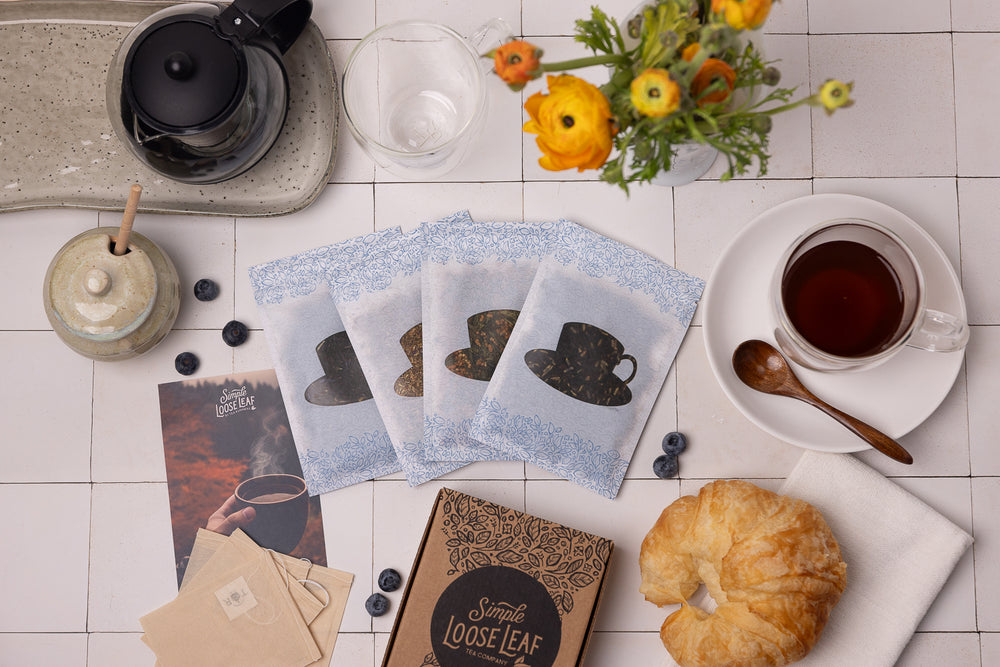What is White Tea?
Many proven health benefits, light and airy sweet floral flavor and beautiful leaves are only some of the reasons white tea is receiving more and more attention from tea drinkers worldwide. The birthplace of today’s white tea is the Chinese province of Fujian. Learn about the history of white tea, different types, flavor profile and benefits.
 Pai Mu Tan or White Peony white tea[/caption]
Pai Mu Tan or White Peony white tea[/caption]
What is white tea?
White tea is one of the main six tea type. Unlike with green, oolong or black tea, there are only a few types of white tea in the world. The most popular ones are Silver Needle, Pai Mu Tan or White Peony, Shou Mei, Gong Mei and less common, Yue Guang Bai and New Technique white tea. Although the most of white tea is produced in China, especially in Fujian, the birthplace of this type, other countries like Sri Lanka, Japan and India producing their own types too, mostly in the form of a silver needle. Silver Needle will contain only buds and Pai Mu Tan will have a bud and one or two leaves. Gong Mei and Shou Mei will both contain buds but second, third and fourth leaf as well.What is white tea made of?
Just like any other real tea, it’s made from Camellia sinensis. Camellia sinensis is a tea plant used for making all real teas – white, yellow, green, oolong, black and dark. The most popular varieties of the Camellia sinensis tea plant are Camellia sinensis var sinensis and Camellia sinensis var assamica. They are both used for making white tea. White tea from Fujian will mostly come from the sinensis variety, while the white tea from the Chinese Yunnan province or India usually comes from assamica te plant.How is white tea made?
What makes white tea unique is the processing method. Tea leaves are very lightly processed. For example, green tea includes a step “kill green“ to stop the oxidation and preserve color and nutrients and black tea is fully oxidized. Processing of green and black tea includes other steps too, such as rolling and shaping the tea leaves. White tea is different. To make white tea, leaves are only withered and dried. This type of tea, even though it’s very light in color, is actually lightly oxidised because the oxidation starts immediately after the leaves are harvested. In general, more oxidised teas will have a darker and stronger color and flavor. Although the process of making this type of tea sounds easy, it takes a lot of knowledge and attention to result in leaves with beautifully preserved color, nutrients and freshness.Does white tea have caffeine?
It’s often considered that white tea has the least caffeine, and sometimes even referred to as almost caffeine free. However, it’s almost impossible to say how much caffeine is in each and every cup of tea. Type of tea leaves, varietal, harvest time and processing methods will all have an influence on the final caffeine content. Teas that contain more buds are likely to have more caffeine, while the more mature older leaves are a better choice if you want to reduce caffeine intake.How much caffeine does white tea have?
Therefore, Silver Needle white tea will generally have the most caffeine of all white teas. White Peony on the other hand, a tea that contains bigger leaves as well but is also harvested in spring, is likely to have less than Silver Needle, but more than Shou Mei, a tea made from later harvests containing both buds, leaves and stalks. One research on 37 commercially available teas showed that Pai Mu Tan white tea had much more caffeine than many green and black teas, especially Ceylon and Darjeeling, with 18 mg per gram of leaves[1]. Not a negligible amount, compared to 14 mg in Darjeeling and only 11 mg in Chinese sencha.What are white tea benefits?
Similar to green tea, white tea contains L-theanine, caffeine and a catechin EGCg (epigallocatechin gallate). EGCG as an antioxidant has a cell-protective power and many other benefits that make tea one of the healthiest drinks in the world. Other compounds often researched for beneficial properties are gallic, caffeic, chlorogenic or cinnamic acids, quercetin and proanthocyanidols, caffeine, theophylline, l-theanine and minerals such as fluorine, manganese or chromium[2]. Studies have shown that white tea has the highest levels of GABA[3] and EGCg, potentially higher than some green teas[4]. Because white tea is the closest to fresh leaves of a tea plant, it doesn’t surprise it contains more nutrients, not destroyed by the regular processing methods for green and black tea. The maximum possible amount of catechins in the white tea is much higher than the maximum amount of catechins in green tea. Furthermore, to be released into water, antioxidants need specific water temperature. Temperature used for brewing tea is quite often higher than the one for brewing green tea. This is one more reason why with a proper brewing, white tea might give more benefits than green tea.
Delicate white tea
Top benefits of white tea
Some of the most important potential benefits of white tea include antimutagenic properties, anti-inflammatory properties, anti-aging properties, protecting teeth, reducing the risk of heart disease and weight loss benefits.1. Boosting immune system
Just like green tea, white tea is also rich in EGCg[5], an important catechin linked to many health benefits. Polyphenols in white tea may help fight free radicals and prevent the cell damage.2. Antimutagenic properties
Research says that polyphenol in the white tea may have antimutagenic properties[6]. They may help prevent or even delete mutations in cells[7] and possibly prevent them from growing into tumors. Both gallic acid and catechins in the white tea are antimutagens. While self-treating cancer with tea is not advisable, taking tea as an enjoyable daily routine is a good way to add value to your lifestyle.3. Anti inflammatory properties
Another study suggests that white tea might reduce the risk of inflammation and risk of other diseases related to inflammation. An anti-inflammatory effect might come from a caffeic acid found in the white tea.[8]4. Anti aging properties
White tea has gained popularity as a beauty tea, and studies have shown that this name might be justifiable. It’s often an ingredient in many skincare products. This tea type may have a “potential anti-ageing activity via inhibition of collagenase and elastase”[9] and may help to protect the skin cells from the sun damage[10] and premature aging.5. Benefits for oral health
Next, drinking white tea in the absence of toothbrush could be a good way of preventing bacteria from invading the mouth. A recent research showed “white tea mouth rinse potently inhibits plaque formation”[11]. Moreover, white tea is less likely to stain teeth because it contains less tannins than black or green tea, a compound responsible for staining teeth. Another research showed that EGCG may help reduce the destruction of all tissues surrounding the teeth[12].6. Energy boost
White tea may contain high levels of caffeine, sometimes even higher than green or black tea. However, white tea is rich in L-theanine, an amino acid with a potential calming effect[13]. Therefore, tea will always provide more sustainable energy than a cup of coffee.7. Weight loss benefits
Although green tea is the most popular type of tea for achieving weight loss goals, white tea may help too. Studies showed that white tea extract may help reduce the fat in blood and help burn stored fat[14]. Read about the difference between white and green tea here.What does white tea taste like?
White tea has a range of flavors – from delicate, airy and slightly sweet to a more nutty, fresh hay and maltiness, all depending on the terrior, tea varietal, picking and processing methods. To preserve the most freshness and flavor, storage conditions are important too. Common white tea will usually lose flavor after a year, but many of them can be aged, and with proper aging conditions, will develop a distinctive and mellow flavor. Gentle high-quality Silver Needle is as light as the first fresh Long Jing, but with more airiness and sophistication. It has a very delicate flavor that is well-loved by many tea drinkers around the world. The lower the grade and the more leaves and stalks it contains, the stronger both color and taste will be. Pai Mu Tan has a stronger flavor, with more sweetness, a delicate hay note and some floral notes. Neither high nor low quality white tea should be pungent and bitter with moldy hay notes. Always brew white tea with hot water, but never boiling. Steep for 1-3 minutes and drink while still hot. You can re-use the same white tea leaves at least three times. Learn how to brew white tea here. [caption id="attachment_2802" align="aligncenter" width="601"] Pai Mu Tan or White Peony white tea[/caption]
Pai Mu Tan or White Peony white tea[/caption]
Disclaimer: The purpose of this article is not to diagnose or treat any diseases, or to replace an opinion of a professional doctor. Never self-treat any diseases, or drink large quantities of tea, real or herbal, if you are suffering from serious diseases, are pregnant or breastfeeding. Every person is different, and it’s impossible to make a general statement about the benefits or side-effects.
References:
[1] https://www.ncbi.nlm.nih.gov/pmc/articles/PMC4787341/ [2] https://www.ncbi.nlm.nih.gov/pubmed/28640307 [3] https://www.sciencedirect.com/topics/agricultural-and-biological-sciences/white-tea [4] https://www.hevs.ch/media/document/0/antioxidantcapacityoftea.pdf [5] https://www.sciencedirect.com/topics/agricultural-and-biological-sciences/white-tea [6] https://www.ncbi.nlm.nih.gov/pubmed/11448643 [7] https://www.ncbi.nlm.nih.gov/pmc/articles/PMC3990861/ [8] Dillenburg Meinhart, Adriana & Miranda, Lucas & Mateus Damin, Fernanda & Teixeira, Jose & Godoy, Helena. (2018). Analysis of chlorogenic acids isomers and caffeic acid in 89 herbal infusions (tea). Journal of Food Composition and Analysis. 73. 10.1016/j.jfca.2018.08.001. [9] https://www.ncbi.nlm.nih.gov/pmc/articles/PMC3214789/ [10] https://www.sciencedaily.com/releases/2003/01/030130081227.htm [11] https://www.researchgate.net/publication/314287468_The_antiplaque_efficacy_of_white_tea_extract_mouthrinse [12] https://www.ncbi.nlm.nih.gov/pmc/articles/PMC3498696/ [13] https://www.ncbi.nlm.nih.gov/pmc/articles/PMC4787341/ [14] https://nutritionandmetabolism.biomedcentral.com/articles/10.1186/1743-7075-6-20
More from:
SLL




Leave a comment